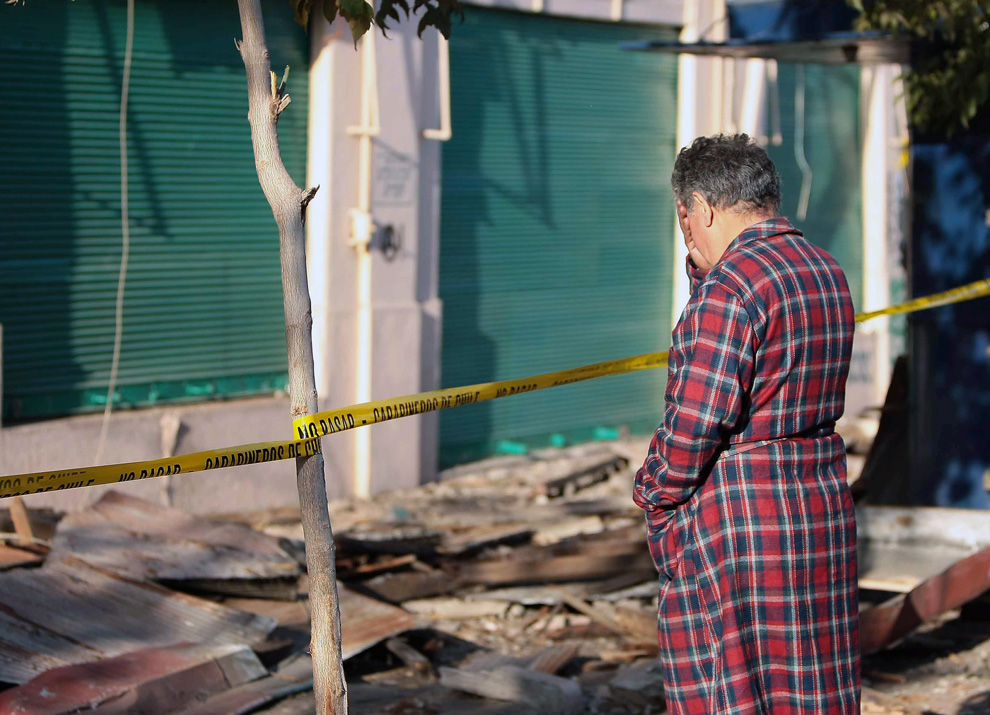foto de Jorge Amengual
Excelente artigo de Alexei Barrionuevo (no Rio de Janeiro) e Liz Robbins (em Nova Iorque), organizando as últimas sobre o terramoto no Chile (com linkagem para mais, na lateral):
‘State of Catastrophe’ After Chile Quake no NY Times.
A deadly 8.8-magnitude earthquake struck central Chile early Saturday, ripping apart buildings, highways and bridges and leaving a path of smoky rubble across a long swath of this earthquake-tested country before sending waves rumbling across the Pacific Basin.
At least 300 people died, according to local news services that quoted the director of Chile’s emergency management office, and more than 1.5 million people were displaced. The death toll was expected to rise, particularly around Concepción, Chile’s second-largest metropolitan area, which is roughly 70 miles from the quake’s center.
President Michelle Bachelet, speaking at a news conference on Saturday night, called the quake “one of the worst tragedies in the last 50 years” and declared a “state of catastrophe.”
While this earthquake was far stronger than the 7.0-magnitude one that ravaged Haiti six weeks ago, the damage and death toll in Chile are likely to be far less extensive, in part because of strict building codes put in place after devastating earthquakes.
The quake Saturday, tied for the fifth largest in the world since 1900, set off tsunami waves that swamped some nearby islands before moving across the Pacific. Hawaii began evacuations before dawn, but by early afternoon there — more than 15 hours after the earthquake first struck 6,500 miles away — the fears of a destructive wave had passed. Countries including Japan and the Philippines were on alert and ordered limited evacuations in anticipation of waves hitting Sunday.
In Santiago, the capital, residents reported having been terrified as the city shook for about 90 seconds.
Although there were long lines at supermarkets and gas stations, and damaged buildings and roads, the capital city, according to residents there, was mostly calm by the late afternoon Saturday. But the scene was grimmer in Concepción and surrounding areas to the south.
In Talca, 167 miles south of Santiago, almost every home in the center of the city was severely damaged, and on Saturday night, people slept on the streets in the balmy night air near fires built with wood from destroyed homes.
In Chillán, 69 miles from Concepción, a crumbling wall allowed 300 prisoners to escape and incite a riot, according to La Tercera, the nation’s largest newspaper. The police captured 60 inmates, but more than 200 were still at large, the newspaper reported on its Web site. With major highways and bridges destroyed, and slabs of concrete jabbing diagonally into the air, transportation slowed or was halted altogether.
Major seaports and airports, including the main airport in Santiago, were out of operation across the central region, Chilean officials said. TV Chile reported that part of the ceiling at the airport had collapsed, but that runways appeared intact. Cellphone and Internet service was sporadic throughout the country, considered one of the most wired in Latin America, complicating rescue efforts.
On Robinson Crusoe, one of the coastal islands hit by early waves, authorities said at least four people had been killed.
The earthquake struck at 3:34 a.m. in central Chile, centered roughly 200 miles southwest of Santiago at a depth of 22 miles, the United States Geological Survey reported.
The Geological Survey said that another earthquake on Saturday, a 6.3-magnitude quake in northern Argentina, was unrelated. In Salta, Argentina, an 8-year-old boy was killed and two of his friends were injured when a wall collapsed, The Associated Press reported.
The most powerful earthquake ever recorded was also in Chile: a 9.5-magnitude quake struck in the spring of 1960 that struck near Concepción and set off a series of deadly tsunamis that killed people as far away as Hawaii and Japan.
But that earthquake, which killed nearly 2,000 people and left more than two million homeless at the time, prepared officials and residents in the region for future devastating effects.
Shortly after a 7.8-magnitude earthquake struck in Valparaíso in 1985, the country established strict building codes, according to Andre Filiatrault, the director of the Multidisciplinary Center for Earthquake Engineering Research at the University at Buffalo.
“There is a lot of reinforced concrete in Chile, which is normal in Latin America,” Professor Filiatrault said. “The only issue in this, like any earthquakes, are the older buildings and residential construction that might not have been designed according to these codes.”
This was in direct contrast to Haiti, which was unprepared for the Jan. 12 earthquake, Professor Filiatrault added.
“If you are considering this magnitude is 8.8, I would be very surprised if the death tolls come close,” Professor Filiatrault said.
via NY Times
* com colaborações de Eric Lipton e Ginger Thompson (Washington); Charles Newbery e Vinod Sreeharsha (Buenos Aires); Charles E. Roessler (Kauai, Hawaii); Tomás Munita (Santiago,Talca, Chile); Andres Schipani (La Paz, Bolivia); Maria Eugenia Diaz (Caracas, Venezuela) e Sarah Wheaton (Nova Iorque).
























0 comentários:
Postar um comentário